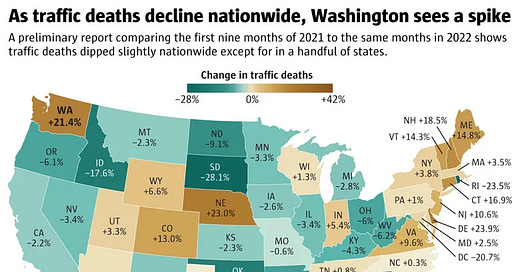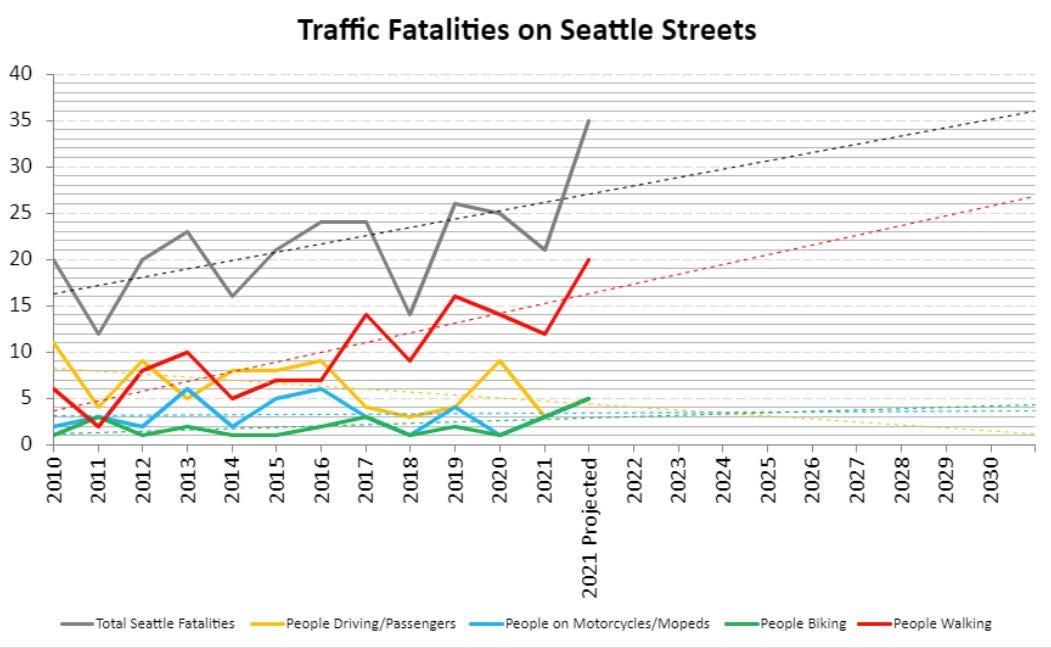The Best Laid Plans
The City of Seattle says it is planning to drastically shift us toward the kind of clean, accessible, space-efficient transportation that makes leading cities successful. It is well known that these kinds of changes are also necessary for us to hit our total emissions targets in time.
But the City Council clearly has something else in mind.
Their biggest priority is making it easier to drive, despite the fact that driving and pedestrian deaths are at a decades-long high.
Images from the Urbanist and the Seattle Times, respectively.
Life is a Highway
For the coming levy renewal, they nearly doubled car-centric spending–and accounting for inflation in construction costs—increased it by 36%. Yes, we have a backlog of road maintenance to address that requires added investment. But those projects should not take precedence over public transit, especially when there was adequate room to expand the total levy. Instead of making us all safer, the Council chose to pit drivers’ needs against everyone else.
The Council claimed voters’ alleged “tax fatigue” forced their hands into this false choice, but recent polling suggests Seattleites would have put their money where their values are in preventing traffic deaths and combating climate change. Almost 80% of Seattle residents support much more aggressive investments in transit and biking and pedestrian safety, to the tune of up to $400M more dollars than the Council’s levy.
Less Transit Investment
The most grotesque change brought by this Mayor and Council is the cut to transit investments. When factoring inflation of construction costs, transit investments from this levy will be down by 36% per year.
Given the promise to “get back to the basics” it is clear whose needs this city council considers “basic” and whose needs they feel comfortable ignoring.
Freight investment also got the shaft–down by 29%--though I suspect that was due to finishing the Lander Street overpass. Still, it’s a significant cut. Bikes were roughly a wash, up 8% in construction-inflation-adjusted terms. However, now that we can finally start expecting bike lanes that are less likely to kill us, the total output may be less than the last levy, since genuinely safe bike lanes are more expensive.
The only sunny(ish)-spot was sidewalks. Total pedestrian spending is up a construction-inflation-adjusted 26%, with a heavy emphasis on sidewalks. That said, the increase could be more than that, and the money focused on cutting violent deaths on our roads should also be much more substantial.
Saka Saga
To his credit, Transportation Chair Rob Saka did push us toward something a bit better than Harrell’s original half-measure, which was so tepid it was even publicly panned by one of his allies. But that was a very low bar to beat.
And in “leading” this process, Saka has hardly covered himself in glory. He publicly shut down a Seattle Department of Transportation staffer from presenting to the council on a plan to ensure that levy funds are distributed in ways that prioritize equity and financial sustainability.
Saka also spoke derogatorily and misleadingly about equity-focused funding as some sort of slush fund, which prompted a rare, public clap back by SDOT’s Director Greg Spotts.
We could have had a better, faster process, and a better outcome.
A Shrinking Slice of the Pie
The bill actually puts less of our economy into transportation than the last levy did.
With 21% more people and 44% more money per family than in 2015, Seattle’s economy is 73% larger than it was when we passed the last levy.
The absolute dollar for dollar increase (67%) means we are spending a lesser share of our income on these critical issues. And that is setting aside inflation and the fact that a much richer city should be spending a larger share of its income on providing a safe, clean, green, convenient, livable place to live for everyone.
It’s not like we didn’t have a chance to make this better. Leaders in the disability, biking and transit advocacy communities fought hard for more for the last few months. Tammy Morales proposed significant improvements that aligned with the preference of 8 out of 10 Seattle residents.
But alas, better was rejected, and this is what we got.
Yes, I currently plan to vote for it. But I’d also support an initiative for a much bigger supplemental levy that actually addresses what the people want.
*Correction: an earlier version of my first piece on this transportation levy annualized a transit related figure for the levy when the figure provided was for the total levy. Sorry.
**Here is a link to my source on nonresidential construction cost inflation. Presumably this is skewed by commercial construction and actual infrastructure inflation costs are even higher, meaning I have likely understated my case here.





